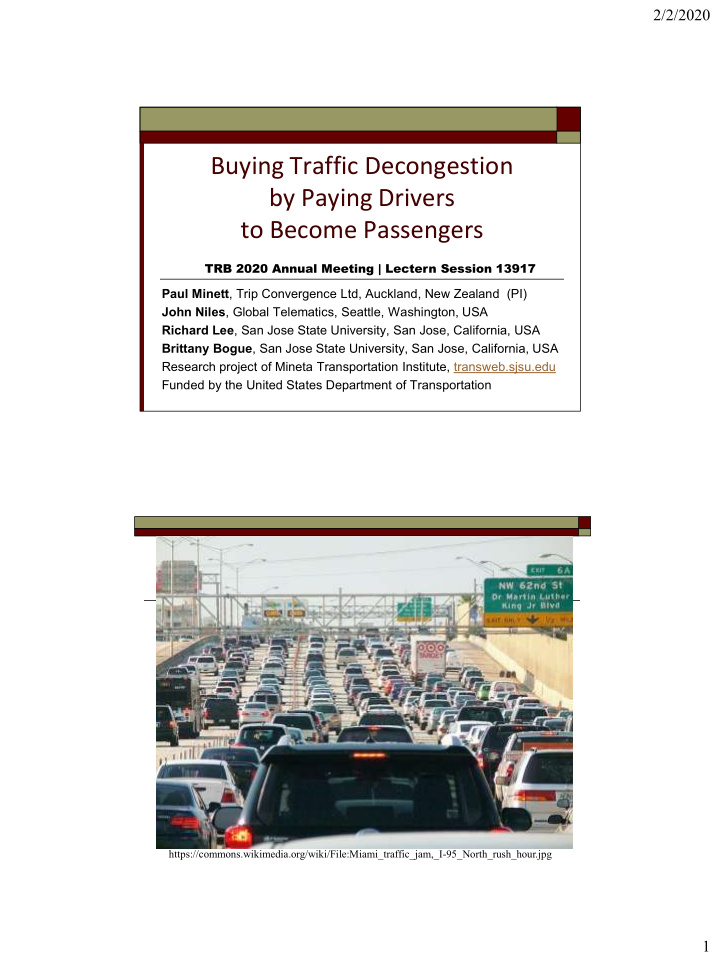



2/2/2020 Buying Traffic Decongestion by Paying Drivers to Become Passengers TRB 2020 Annual Meeting | Lectern Session 13917 Paul Minett , Trip Convergence Ltd, Auckland, New Zealand (PI) John Niles , Global Telematics, Seattle, Washington, USA Richard Lee , San Jose State University, San Jose, California, USA Brittany Bogue , San Jose State University, San Jose, California, USA Research project of Mineta Transportation Institute, transweb.sjsu.edu Funded by the United States Department of Transportation https://commons.wikimedia.org/wiki/File:Miami_traffic_jam,_I-95_North_rush_hour.jpg 1
2/2/2020 U.S. Carpool Commuting Mode Share Low & Dropping SOV MODE SHARE 70% to 80% typical urban CARPOOL MODE SHARE 8% to 13% typical urban Proposed Solution for Reducing Congestion Dynamically achieve a target level of reduced vehicle traffic by motivating enough SOV commuters to become passengers o Determine the amount of daily cash to pay drivers to switch to being passengers o Pay enough, per person and in total, to achieve the lower target o Establish as a permanent system 2
2/2/2020 STEPS in FULL SOLUTION DESIGN • Define corridor • Gather base data • Count traffic • Set desired traffic reduction • Determine incentive cost • Determine incentive structure • Calculate gross cost Project Sought Full • Calculate year 1 total cost Solution Design • Estimate later years cost • Forecast lifetime cost & B/C present value Case study site in California 3
2/2/2020 Case Study Site in The Bay Area 4
2/2/2020 Case study site: Half Moon Bay, CA Case study: A Simple Bottleneck 5
2/2/2020 Half Moon Bay Road to Silicon Valley Case Study Bottleneck 6
2/2/2020 Key Steps in the Full Design Surveyed Half Moon Bay citizens on attitudes, travel behavior, and stated preferences for change Estimated price sensitivity in commuters becoming passengers Did spreadsheet-based simulation of traffic dynamics Calculated cost and benefit estimates for permanent implementation Main Data Source: Resident Survey o Geographic filtering of all-county voters list o 588 emails sent out that pointed to an online questionnaire o 120 responses made. Closely matched census demographics o Sought travel behavior on “Typical Tuesdays ” o Personal strategies to avoid congestion? o Willing to travel as passenger? o What incentive payment needed? 7
2/2/2020 Response to Congestion None: 5% 18% Leave 12% Work Early to Allow from Home for Congestion 37% Leave Later 28% Leave to Avoid Early to Avoid Congestion Congestion Estimated Tuesday Morning Traffic Half Moon Bay, Summer 2019 Red shows traffic delayed at the bottleneck on State Route 92 Green is the extent of queue 8
2/2/2020 Survey Response: Willingness to Share the Ride Reward Sought for Being a Passenger 9
2/2/2020 Simulated Tuesday Morning Traffic Half Moon Bay, Summer 2019 with Incentive-stimulated car pooling Red shows traffic still delayed Green shows remaining queue Discovery: Reactive later departures would rebuild peak congestion 3,700 commuters estimated to currently pass through the bottleneck between 5 am and 9 am. But with congestion dissipated: 2,600 (71%) would shift to a later departure for a total of 1,735 hours more time at home 620 (17%) would shift to an earlier departure for a total of 490 hours of additional time at destination. 10
2/2/2020 Intra-peak Demand Shift is Significant Current traffic in blue | Desired travel times IF no congestion in green The Good News Analytical, empirical evidence in case study finds that a daily average $15 price per passenger motivates enough SOV commuters to become passengers that congestion is removed. Removing congestion would allow people (88% in case study) to move departures to preferred times, so a going- early or going-late bonus is required to avoid re-peaking. 20-year present value benefit @ 3% discount rate is $640 million vs $140 million in costs; 4.5 benefit : cost. Cost of this system may compete well with widening the highway or building/buying new transit infrastructure. 11
2/2/2020 $640 Million, 20 Year Benefits, NPV $140 Million, 20 Year Costs, NPV 12
2/2/2020 Bottom Line Pending more peer review and your comment, research team is eager to work further on congestion- clearing-payments methodology. Our documented, detailed, eight-step method is ready for funding support of further testing in an innovative community. Your suggestions, please?! Envisioned as an iteratively-tuned, ITS-enabled system of congestion relief – a game-changer! Thanks! PaulMinett@gmail.com or J@JohnNiles.com 13
Recommend
More recommend